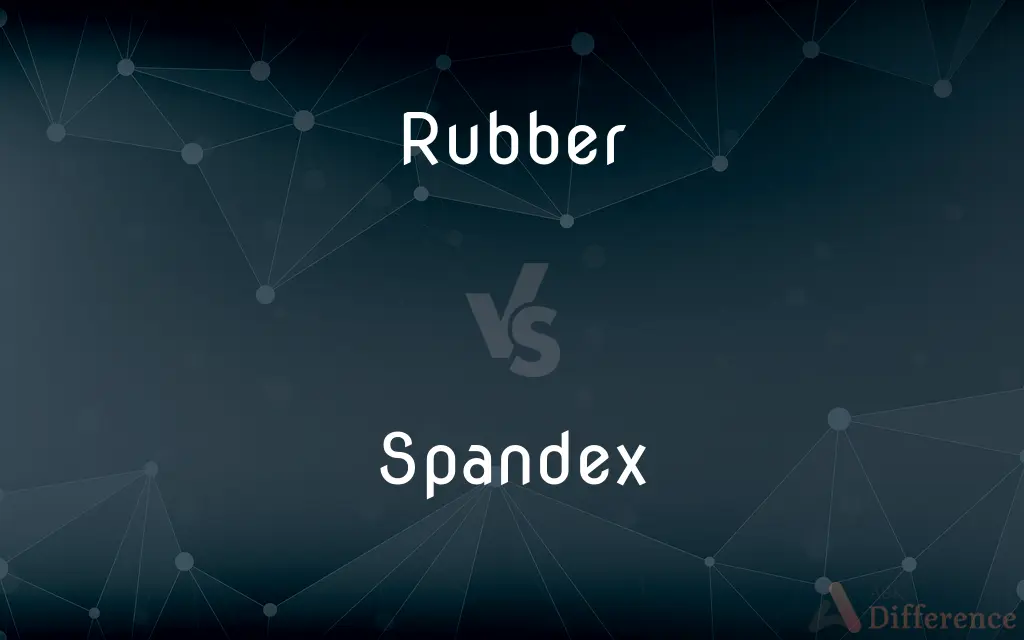Rubber vs. Spandex — What's the Difference?
Edited by Tayyaba Rehman — By Maham Liaqat — Updated on March 26, 2024
Rubber is elastic and durable, originating from plants or synthetically made, while spandex is a synthetic fiber known for extreme elasticity and strength.

Difference Between Rubber and Spandex
Table of Contents
ADVERTISEMENT
Key Differences
Rubber, a highly elastic material, is derived from the latex of certain plants or can be synthetically produced. It's known for its durability, resistance to water and chemicals, and is used in a wide variety of products from tires to waterproof clothing. Spandex, on the other hand, is a synthetic fiber, also known for its exceptional elasticity, often exceeding that of rubber. Spandex is lightweight and comfortable, making it ideal for clothing that requires a high degree of flexibility, such as athletic wear, swimwear, and undergarments.
While rubber is used in a myriad of applications beyond clothing, such as in the automotive industry for tires, seals, and gaskets, and in the manufacturing of medical supplies like gloves, spandex is primarily found in the textile industry. Its main appeal in textiles is its ability to stretch up to five times its original length and return to its original state, providing an unparalleled fit and freedom of movement for the wearer.
The production process for rubber, especially natural rubber, involves tapping rubber trees to collect latex, which is then processed and vulcanized to improve its properties. Synthetic rubber is produced through polymerization of monomers like butadiene and isoprene. Spandex is made from polyurethane, which is a polymer, and its production involves a series of chemical reactions that create long, elastic fibers. This chemical foundation gives spandex its remarkable stretchability and recovery properties.
In terms of environmental impact, natural rubber is renewable and biodegradable, but its cultivation can lead to deforestation and biodiversity loss if not managed sustainably. Synthetic rubber and spandex are petroleum-based, making them less environmentally friendly due to their non-renewable origin and challenges in recycling and degradation.
Despite their different origins and applications, both rubber and spandex have revolutionized the products in which they are used. Rubber has made possible durable, weather-resistant products that are essential in daily life and various industries, while spandex has transformed fashion and sportswear with its incredible stretch and comfort, allowing for designs that conform closely to the body without restricting movement.
ADVERTISEMENT
Comparison Chart
Origin
Natural (plant latex) or synthetic
Synthetic (polyurethane)
Primary Use
Tires, seals, waterproof items, medical supplies
Athletic wear, swimwear, undergarments
Elasticity
Highly elastic, but less so than spandex
Extremely elastic, stretches up to five times
Production Process
Tapping of latex, vulcanization for natural rubber
Chemical synthesis of polyurethane
Environmental Impact
Renewable but can cause deforestation; synthetic rubber is not biodegradable
Petroleum-based, challenges in recycling and degradation
Key Properties
Durability, water and chemical resistance
Lightweight, high flexibility, and recovery
Compare with Definitions
Rubber
High elasticity and durability.
Rubber bands are widely used due to their strong elasticity.
Spandex
Challenges in recycling.
The petroleum basis of spandex makes it less environmentally friendly.
Rubber
Environmental considerations.
Sustainable harvesting methods are important for natural rubber production.
Spandex
Primarily used in textiles.
Spandex is a popular material for sports bras and other athletic wear.
Rubber
Derived from plants or synthetically.
Natural rubber is tapped from rubber trees, while synthetic rubber is made from petroleum.
Spandex
Synthetic origin.
Spandex is created through the chemical synthesis of polyurethane.
Rubber
Variety of applications.
Rubber is essential in making tires for vehicles.
Spandex
Extreme elasticity and strength.
Spandex leggings can stretch significantly without tearing.
Rubber
Water and chemical resistant.
Rubber gloves provide protection against water and chemicals.
Spandex
Lightweight and comfortable.
Spandex adds comfort and flexibility to clothing.
Rubber
A tough elastic polymeric substance made from the latex of a tropical plant or synthetically
A rubber plantation
A rubber dinghy
Heat and sunlight may cause rubber to deteriorate
Spandex
Spandex, Lycra, or elastane is a synthetic fiber known for its exceptional elasticity. It is a polyether-polyurea copolymer that was invented in 1958 by chemist Joseph Shivers at DuPont's Benger Laboratory in Waynesboro, Virginia, US.The generic name "spandex", which is an anagram of the word "expands", is the preferred name in North America.
Rubber
A piece of rubber used for erasing pencil or ink marks
A pencil with a rubber at the end
Spandex
A type of stretchy polyurethane fabric
Gold spandex leggings
Rubber
Rubber boots; galoshes.
Spandex
A synthetic fiber or fabric made from a polymer containing polyurethane, used in the manufacture of elastic clothing.
Rubber
A condom.
Spandex
Of or relating to spandex or its elastic qualities.
Rubber
A contest consisting of a series of successive matches (typically three or five) between the same sides or people in cricket, tennis, and other games
The opening rubber of Britain's Davis Cup tie against Argentina
Spandex
A synthetic fibre known for its exceptional elasticity.
Rubber
A yellowish, amorphous, elastic material, composed almost entirely of an isoprene polymer, obtained from the milky sap or latex of various tropical plants, especially the rubber tree, and vulcanized, pigmented, finished, and modified into products such as electric insulation, elastic bands and belts, tires, and containers. Also called caoutchouc, India rubber.
Spandex
Clothing made from such material.
Rubber
Any of numerous synthetic elastic materials of varying chemical composition with properties similar to those of natural rubber; an elastomer.
Spandex
An elastic textile material, used for clothing
Rubber
A low overshoe made of rubber.
Spandex
An elastic synthetic fabric
Rubber
(Baseball) The rectangular piece of hard rubber that the pitcher must remain in contact with when making a pitch.
Rubber
An eraser.
Rubber
A tire.
Rubber
A set of tires on a vehicle.
Rubber
(Slang) A condom.
Rubber
One that rubs, especially one that gives a massage.
Rubber
A series of games of which two out of three or three out of five must be won to terminate the play.
Rubber
An odd game played to break a tie.
Rubber
(uncountable) Pliable material derived from the sap of the rubber tree; a hydrocarbon polymer of isoprene.
Rubber
Synthetic materials with the same properties as natural rubber.
Rubber
An eraser.
Rubber
A condom.
Rubber
(countable) Someone or something which rubs.
Rubber
One who rubs down horses.
Rubber
One who practises massage.
Rubber
A coarse towel for rubbing the body.
Rubber
An abrasive for rubbing with: a whetstone, file, or emery cloth, etc.
Rubber
(historical) The cushion of an electric machine.
Rubber
The rectangular pad on the pitcher's mound from which the pitcher must pitch.
Jones toes the rubber and then fires to the plate.
Rubber
Water-resistant shoe covers, galoshes, overshoes.
Johnny, don't forget your rubbers today.
Rubber
Tires, particularly racing tires.
Jones enters the pits to get new rubber.
Rubber
A hardship or misfortune.
Rubber
(sports) In relation to a series of games or matches between two competitors where the overall winner of the series is the competitor which wins a majority of the individual games or matches:
Rubber
The entire series, of an odd number of games or matches in which ties are impossible (especially a series of three games in bridge or whist).
Rubber
An individual match within the series (especially in racquet sports).
Rubber
A rubber match; a game or match played to break a tie.
Rubber
The game of rubber bridge.
Rubber
Not covered by funds on account.
Rubber
(telephony) To eavesdrop on a telephone call
Rubber
(slang) To rubberneck; to observe with unseemly curiosity.
Rubber
One who, or that which, rubs.
Rubber
In some games, as bridge or whist, the odd game, as the third or the fifth, which decides the winner when there is a tie between the players; as, to play the rubber; also, a contest determined by the winning of two out of three games; as, to play a rubber of whist.
Rubber
India rubber; caoutchouc; gum elastic; - also called natural rubber.
Rubber
Any substance, whether natural or synthetic, resembling India rubber with respect to its elasticity[1].
Rubber
A low-cut overshoe made of natural or synthetic rubber[4], serving to keep the feet and shoes dry when walking in the rain or on a wet surface; - usually used in the plural.
Rubber
A condom.
Rubber
Latex from trees (especially trees of the genera Hevea and Ficus)
Rubber
An eraser made of rubber (or of a synthetic material with properties similar to rubber); commonly mounted at one end of a pencil
Rubber
A waterproof overshoe that protects shoes from water or snow
Rubber
Coat or impregnate with rubber;
Rubberize fabric for rain coats
Rubber
Made of rubber and therefore water-repellent;
Rubber boots
Rubber
Returned for lack of funds;
A rubber check
A no-good check
Common Curiosities
Can rubber be used in clothing?
Yes, rubber can be used in clothing, especially for waterproof items and accessories, but it's less common than spandex for tight-fitting or stretchable garments.
What is the main difference between rubber and spandex?
Rubber is known for durability and resistance, originating from plants or synthetically, while spandex is a synthetic fiber prized for extreme elasticity and strength.
Why is spandex preferred in athletic wear?
Its ability to stretch significantly and return to its original shape offers unparalleled comfort and flexibility, essential for athletic performance.
Is natural rubber biodegradable?
Yes, natural rubber is biodegradable, unlike synthetic rubber and spandex, which are not easily degraded.
Are there environmental concerns associated with rubber and spandex?
Yes, natural rubber cultivation can lead to deforestation, while both synthetic rubber and spandex, being petroleum-based, pose challenges in degradation and recycling.
How is synthetic rubber different from natural rubber?
Synthetic rubber is made from petroleum products through chemical synthesis, offering properties similar to natural rubber but with variations in performance and environmental impact.
What makes spandex recover its shape after stretching?
The molecular structure of polyurethane, from which spandex is made, allows it to return to its original shape after being stretched.
What is the role of rubber in the automotive industry?
Rubber is crucial for making tires, seals, and hoses, providing durability and resistance essential for vehicle operation.
Why is vulcanization important in rubber production?
Vulcanization improves rubber's properties, such as its elasticity, strength, and durability, making it more useful for a wide range of applications.
What are the health implications of wearing spandex?
While generally safe, tight spandex garments can restrict circulation if worn too tightly or for too long.
Can spandex stretch more than rubber?
Yes, spandex can stretch up to five times its original length, making it more elastic than rubber.
How does spandex influence fashion design?
Its stretchability allows for body-conforming garments that are comfortable and flexible, expanding the possibilities in fashion design.
Can spandex be recycled?
Recycling spandex is challenging due to its chemical composition and lack of a straightforward process, though research into sustainable practices continues.
How are rubber and spandex made?
Rubber can be tapped from trees or synthesized chemically, while spandex is produced through the synthesis of polyurethane, a type of polymer.
What advancements are being made in rubber and spandex production?
Ongoing research aims to make both materials more sustainable, including efforts to create biodegradable synthetics and improve natural rubber cultivation practices.
Share Your Discovery

Previous Comparison
Conveyance vs. Travel
Next Comparison
Efficacy vs. EfficiencyAuthor Spotlight
Written by
Maham LiaqatEdited by
Tayyaba RehmanTayyaba Rehman is a distinguished writer, currently serving as a primary contributor to askdifference.com. As a researcher in semantics and etymology, Tayyaba's passion for the complexity of languages and their distinctions has found a perfect home on the platform. Tayyaba delves into the intricacies of language, distinguishing between commonly confused words and phrases, thereby providing clarity for readers worldwide.















































